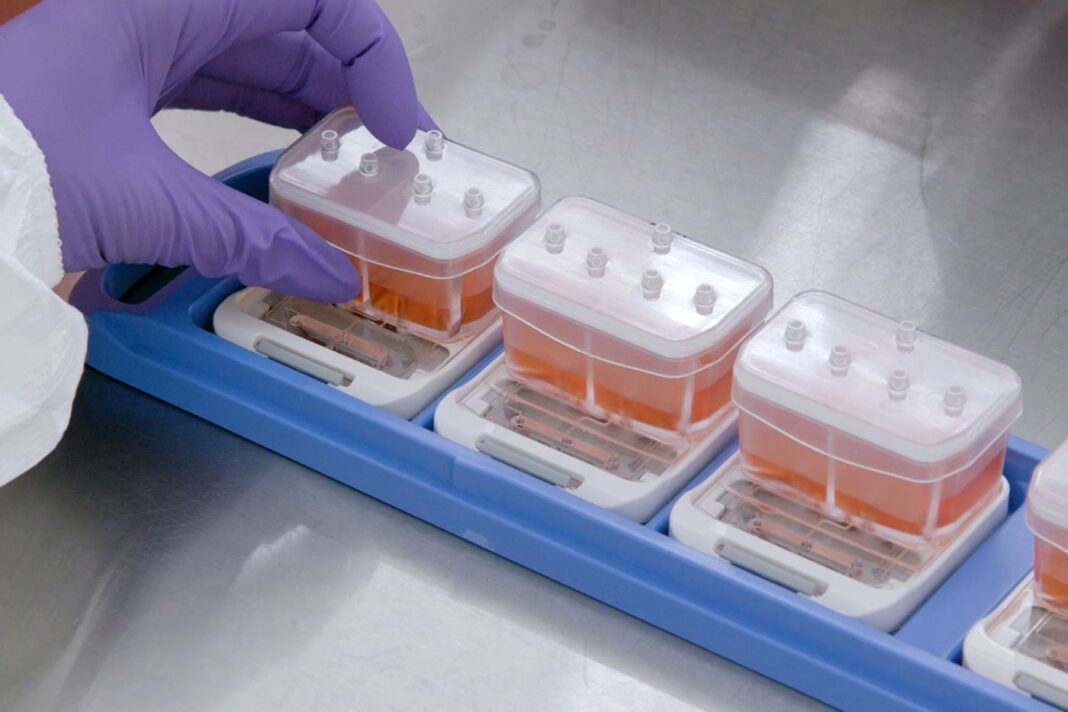By Lorna Ewart, PhD

Chief Scientific Officer
Emulate Bio
Drug-induced liver injury (DILI) is a leading cause of safety-related clinical trial failures and market withdrawals around the world.1–3 While it has plagued drug development for decades, physicians have actually known since the 19th century that certain compounds they would give to patients led to DILI; however, they accepted this as the price they had to pay in the fight to save patients’ lives—or, as stated in a 1965 article by Hans Popper, MD, and his Mount Sinai Hospital colleagues, DILI appeared to be the “penalty for progress” in medicine.4
Today, DILI continually hampers productivity in drug development, revealing itself only when candidate therapeutics enter human trials and begin harming or killing patients. In attempts to prevent DILI-causing drugs from reaching clinical trials, researchers rely on nonhuman animal models to identify signs of toxicity in preclinical trials. Yet, molecular and physiological differences between species make animals fallible predictors of human drug responses.5 As such, DILI remains prominent in clinical settings, accounting for nearly 13% of clinical trial failures.6,7
To better protect patients, researchers need to improve their ability to predict DILI risk during preclinical drug screening. This will require the use of models that are sensitive and specific to a drug’s hepatotoxic potential. With recent policy advancements like the FDA Modernization Act 2.0 allowing nonanimal data as part of an Investigational New Drug (IND) submission, scientists now have the support they need to incorporate animal model alternatives into their preclinical workflows. Recent evidence suggests organ-on-a-chip technology may fill this need. An example of this technology is the Emulate human Liver-Chip.
Sensitive DILI prediction with organ-chips
An organ-on-a-chip platform is an advanced in vitro cell culture model that closely mimics the physiological and tissue-specific conditions that cells are exposed to in vivo. As such, cells that are cultured in organ-on-a-chip platforms show transcriptional and phenotypic profiles that are very similar to their in vivo counterparts. Several different organ-on-a-chip platforms have been shown to accurately replicate the behaviors and complex tissue functions of various organs, including the liver and its responses to hepatotoxic drugs.8
In a recently published paper from Communications Medicine, part of Nature Portfolio, scientists from Emulate reported that the human Liver-Chip has the potential to greatly reduce the number of DILI-inducing drugs that reach the clinic.7 The study showed that this model was capable of detecting hepatotoxic drugs with a sensitivity of 87%. In this context, “sensitivity” describes how often a model successfully identifies a toxic drug candidate as such. So, the Liver-Chip was able to correctly label seven out of eight toxic drugs it encountered.
The performance of the Liver-Chip stands out against that of animal models. The animal models had shown a sensitivity of 0% for the same set of drugs. Notably, the sensitivity of any model system is not a stationary number, but rather changes depending on the compounds that the model system is attempting to detect. Many models can successfully identify a highly corrosive substance like sulfuric acid as being toxic to human tissues, but the job gets much harder when working with real drug candidates.
In this case, the compounds being evaluated had all previously undergone animal testing, which incorrectly found them to be safe for clinical use. Animals thus demonstrate a 0% sensitivity against these drugs, and these drugs, all together, represent the gap in our current drug development pipeline that allows toxic compounds to enter the clinic.7 Collectively, this group of drugs—identified as safe by animal models—claimed the lives of more than 200 patients.
Had it been in use when these drugs were being developed, the Liver-Chip could have saved hundreds of lives.
Specificity: No good drugs left behind
When Popper and colleagues described DILI as the “penalty of progress,” they did so in the midst of widespread uncertainty about how best to protect patients. Caution in prescribing drugs that may induce DILI, the scientists explained, “sometimes protects the patient but almost as frequently prevents beneficial treatment.” In other words, Popper and colleagues were warning against the risk of discarding good therapeutics in our haste to avoid DILI.4
Such a warning applies to preclinical drug screening as well. Sensitive models like the Liver-Chip can help prevent toxic drugs from entering the clinic, but this would mean little if the model were not also specific.
Here, “specificity” refers to how accurate a model is when it classifies a compound as nontoxic. A model with a specificity of 100% would never falsely label a safe compound as toxic. It is important to note that a model can be 100% sensitive without being very specific: A model that labels every drug candidate as toxic will never let a toxic compound go unnoticed (thus having high sensitivity), but it will also mislabel many nontoxic candidates as toxic (having low specificity). Loss of these candidates could mean both the loss of a much-needed drug and delayed treatment for patients in desperate need of help.
Researchers need highly sensitive preclinical toxicology models, as higher sensitivity means more successful clinical trials, safer patients, and better economics. However, this cannot come at the cost of failing good drugs. They are rare, and substantial effort and investment goes into their development. Even one drug that fails to make it to the clinic can end up costing pharmaceutical companies billions and leave a patient population without treatment. Therefore, it is also critical that models classify nontoxic compounds as such.
This is why Emulate scientists set a threshold of 100% specificity when determining the Liver-Chip’s sensitivity. Even while maintaining such a strict specificity, the Liver-Chip achieved a staggering 87% sensitivity. Accordingly, in addition to correctly identifying a majority of toxic drugs, the Liver-Chip never misidentified a nontoxic drug. For drug developers, this means that no good drugs—nor the considerable resources poured into their development—would be wasted.
What’s more, having both high sensitivity and high specificity means that drugs entering clinical trials are more likely to succeed. Failure of drugs in clinical trials comes at a considerable cost.9 With a nearly 90% clinical trial failure rate, the productivity of the drug development industry has been in crisis.6,10 Use of the Liver-Chip in preclinical toxicology is likely to help improve productivity by decreasing safety-
related failures. Economic modeling suggests that the use of the Liver-Chip could generate as much as $24 billion in excess productivity for the industry annually.7
Reducing the penalty
For more than a century, DILI has exacted a significant toll on unsuspecting patients. However, the advent of organ-on-a-chip technology—specifically the Liver-Chip—has inspired a growing hope that DILI will no longer be a threat that looms over drug development projects. With the ability to identify hepatotoxic compounds sensitively and specifically in preclinical settings, the Liver-Chip promises to greatly reduce DILI-related incidents, boost drug development productivity, and enable progress without a DILI penalty.
References
- U.S. Food and Drug Administration. Guidance for Industry Drug-Induced Liver Injury: Premarketing Clinical Evaluation. July 2009.
- Siramshetty VB, Nickel J, Omieczynski C, et al. WITHDRAWN—a resource for withdrawn and discontinued drugs. Nucleic Acids Res. 2016; 44(Issue D1): D1080–D1086.
- Onakpoya I, Heneghan C, Aronson JK. Post-marketing withdrawal of 462 medicinal products because of adverse drug reactions: a systematic review of the world literature. BMC Med. 2016; 14: 10.
- Popper H, Rubin E, Cardiol D, et al. Drug-induced liver disease. Arch Int Med. 1965; 115(2): 128.
- DeKeyser JG, Shou M. Species differences of drug-metabolizing enzymes. In: Lyubimov AV, ed Encyclopedia of Drug Metabolism and Interactions. Hoboken: John Wiley & Sons; 2012: 1–38.
- Sun D, Gao W, Hu H, Zhou S. Why 90% of clinical drug development fails and how to improve it? Acta Pharm Sin B. 2022; 12(7): 3049–3062.
- Ewart L, Apostolou A, Briggs SA, et al. Performance assessment and economic analysis of a human Liver-Chip for predictive toxicology. Commun Med. 2022; 2: 154.
- Ingber DE. Human organs-on-chips for disease modelling, drug development and personalized medicine. Nat Rev Gen. 2022; 23(8): 467–491.
- Paul SM, Mytelka DS, Dunwiddie, CT, et al. How to improve R&D productivity: the pharmaceutical industry’s grand challenge. Nat Rev Drug Disc. 2010; 9(3): 203–214.
- Scannell JW, Blanckley A, Boldon H, Warrington BH. Diagnosing the decline in pharmaceutical R&D efficiency. Nat Rev Drug Disc. 2012; 11(3): 191–200.
Lorna Ewart, PhD, is the Chief Scientific Officer at Emulate Bio.



